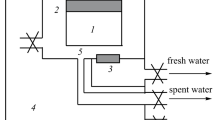Abstract
Cold pumice floating on water slowly absorbs water into the vesicles and eventually sinks. Experiments show that some pumice can remain afloat for over 1 1/2 years. The time taken for enough water to be adsorbed to sink depends on the pumice size, initial density, the size distribution of vesicles and the connectedness of the vesicles. Hot pumice often sinks immediately on immersion in water despite having a lower density than water. Experiments demonstrate that for any pumice there is a critical temperature above which the pumice will sink. Even pumice with a density of 0.2 g/cm3 will sink if the temperature exceeds 700 °C. The critical temperature correlates well with initial pumice density with lower-density pumice requiring higher temperatures to sink. The mechanism at low temperatures (< 150 °C) involves the absorption of water by contraction of hot air within the pumice. However, at higher temperatures conversion of absorbed water to steam in the hot pumice flushes out air, and further cooling results in condensation and absorption of water into the pumice. The experiments on hot and cold pumice suggest that all the vesicles in pumice are interconnected. This was confirmed by vacuum impregnation of pumice with resins. The behaviour of hot and cold pumice indicates that the deposits of hot and cold pyroclastic flow deposits may be distinguishable. Hot deposits will contain a significant proportion of low-density pumice, whereas cold deposits will not. Pumice falling hot onto water could also sink immediately to form subaqueous pumice-fall deposits. The physical properties of pumice were further examined by a nitrogen absorption technique and by mercury porosimetry. The former method shows that pumice has a typical surface area of 0,5 m2/g, corresponding to a sheet of material of 1 m2 and 0,87µm Thick. Porosimetry shows that there are often three apparent vesicle-size populations in pumice. However, the porosimetry data gives surface areas which often greatly exceed those measured by the absorption method. The calculation of surface area by porosimetry assumes that vesicles are open cylinders. The large discrepancy with nitrogen absorption data suggests that the surface areas and proportion of small vesicles are overestimated by porosimetry and that pumice vesicles have narrow entrances. The porosimetry size distributions reflect the dimensions of pore entrances rather than the vesicles themselves. A three stage degassing history was proposed by Sparks and Brazier (1982). However, the small size population of sub-micron vesicles they identified probably represent larger (≫ 1µm) vesicles with narrow entrances. The experimental data indicate that pumice can degas very quickly because of the connectedness of vesicles and high internal surface areas.
Similar content being viewed by others
References
Bond A, Sparks RSJ (1976) The Minoan eruption of Santorini, Greece. J Geol Soc London 132: 1–16
Crank J (1965) The mathematics of diffusion. Oxford University Press
Delaney JR, Karsten JL (1981) Ion microprobe studies of water in silicate melts: concentration-dependant water diffusion in obsidian. Earth and Planet Sci Lett 52: 191–202
Ewart A (1963) Petrology and petrogenesis of the Quaternary pumice ash in the Tampo area, New Zealand. J Petrol 4: 393–431
Fisher RV, Schmincke HU (1984) Pyroclastic rocks. Springer Berlin Heidelberg New York Tokyo pp 1–472
Frick C, Kent LE (1984) Drift pumice in the Indian and South Atlantic Oceans. Trans geol Soc S Africa 87: 19–33
Gregg SJ, Sing SW (1980) Absorption surface and porosity. Academic Press, 2nd ed
Hahn GA, Rose WI, Meyers T (1979) Geochemical correlation of genetically related rhyolitic and air-fall ashes, central and western Guatemala and the equatorial Pacific. Geol Soc Am Spec Pap 180: 101–112
Heiken G (1979) An Atlas of Volcanic Ash. Smithsonian Contrib Earth Sci 12 pp 1–101
Jokiel RL (1984) Long distance dispersal of Reef corals by rafting. Coral Reefs 3: 113–116
Lowell S (1976) Introduction to Powder surface area. Wiley New York pp 1–191
Richards AF (1958) Trans-Pacific distribution of floating pumice from Isla San Benedicto, Mexico. Deep-Sea Res 5: 29–35
Rose WI (1972) Notes on the 1902 eruption of Santa Maria Volcano, Guatemala. Bull Volcanol 34: 29–45
Rose WI, Grant NK, Easter J (1979) Geochemistry of the Los Chocoyos Ash, Quezaltenango Valley, Guatemala. Geol Soc Am Spec Pap 180: 87–89
Sparks RSJ (1978) Gas release rates from pyroclastic flows: an assessment of the role of fluidisation in their emplacement. Bull Volcanol 41: 1–9
Sparks RSJ, Brazier S (1982) New evidence for degassing processes during explosive eruptions. Nature 295: 218–220
Sparks RSJ, Wilson L, Sigurdsson H, (1981) The pyroclastic deposits of the 1975 eruption of Askja, Iceland. Phil Trans R Soc London Set A 299: 241–273
Verbeeck RDM (1886) Mr Verbeeck on Krakatao. Nature 35: 560–561
Wilson CJN (1980) The role of fluidisation in the emplacement of pyroclastic flows: an experimental approach. J Volcanol Geotherm Res 8: 231–249
Wilson L (1980) Relationships between pressure, volatile content and ejecta velocity in three types of volcanic explosion. J Volcanol Geotherm Res 8: 297–314
Wilson L, Sparks RSJ, Walker GPL (1980) Explosive volcanic eruptions-IV. The control of magma properties and conduit geometry on eruption column behaviour. Geophys J R Astron Soc 63, 117–148
Author information
Authors and Affiliations
Rights and permissions
About this article
Cite this article
Whitham, A.G., Sparks, R.S.J. Pumice. Bull Volcanol 48, 209–223 (1986). https://doi.org/10.1007/BF01087675
Received:
Accepted:
Issue Date:
DOI: https://doi.org/10.1007/BF01087675




